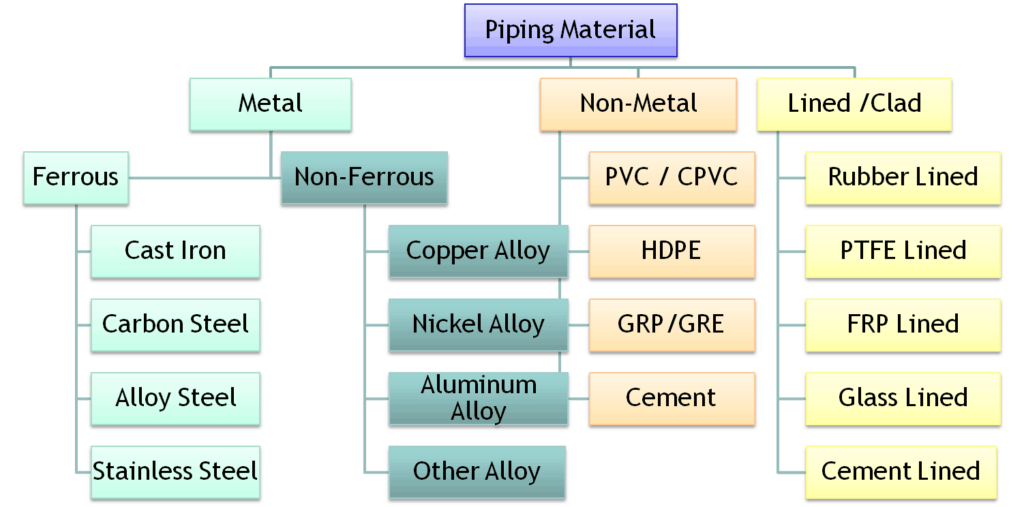Pipe material selection of various components is deepened on the type of materials it transport. Various liquids that can be Flammable, Corrosive, Explosive, Volatile, Reactive, and sometimes Hazardous to human health are transported through a pipeline, which is why selecting proper pipe material is important.
Process Conditions for Pipe Material Selection
Piping material selection mainly depends on process conditions such as
- Types of fluid
- Service temperature
- Operating pressure
Let’s try to understand this condition in depth.
1st, the Process condition that will impact the material selection is the type of fluid it transports. For corrosive fluids, you have to go for higher corrosion resistance material as compared to non-corrosive service.
- Corrosive fluids such as – crude oil, Sea Water, H2S, Ammonia, Acids, etc., require high corrosion resistance material.
- On the other hand, normal carbon steel is enough for Non-Corrosive fluids such as – Lube oil, Air, Nitrogen, etc.
2nd Process condition that will impact the selection of material is the Temperature of fluids
- Cryogenic
- Low temperature
- Medium temperature
- High temperature
An increase or decrease in the service fluid temperature will greatly affect the pipe material’s mechanical properties, such as impact resistance, elongation, and tensile strength; hence, you require special material for both high temperature & Cryogenic services.
3rd Process condition that will impact the selection of material is the Pressure of service fluids. You required high strength material or higher thickness material for high-pressure services compared to normal pressure services.
Other non-process factors that are also considered during material selection are
- Cost of material
- Availability – whether the material is locally available or import is required.
- Weldability and Manufacturability of material also play a vital role in selection. Preference is always given to the material, which does not require any special requirement during welding and manufacturing.
Unlock New Skills with Our Best Selling Online Courses
Pipe Material Properties
Similar to process fluid properties, there are certain material properties that are also considered when selecting pipe material. Some of them are
- Ultimate Tensile Strength – a material’s capacity to withstand when subjected to tension.
- Yield Strength – the load at which plastic deformation or permanent deformation starts.
- Elasticity – a material’s ability to resume its normal shape after the load is removed, just like rubber.
- % Elongation – Percent elongation is a measure of ductility.
- Hardness – is the ability of a material to resist plastic deformation.
- Toughness – The ability of a material to absorb energy before fracture.
- Creep resistance – ability to resist any kind of distortion when under a load over an extended period.
- Fatigue Resistance – a material’s ability to withstand cyclic load for a given number of cycles before it fails.
Now considering both process and the material property, you can choose piping material from a variety of materials available. I have listed different types of material used in process piping to meet various design conditions in this chart. Piping material is broadly classified into three categories. Metal, Nonmetal, and composite, which is a combination of metal to metal or metal to non-metal.
Click on the individual link to learn about each type of material.
Ferrous Metal
Non-Ferrous Metal
- Copper and Copper Alloys
- Nickel and Nickel Alloys
- Aluminum and Aluminum Alloys
- Titanium and Titanium Alloys
- Zirconium and Zirconium Alloys
Non-Metal
- PVC/CPVC
- HDPE
- GRE/GRP
- Cement pipes
Piping Component Quiz – Test yourself, Take This Quiz
Unlock New Skills with Our Best Selling Online Courses
Lined & Clad Pipe
Line and Clad pipes are composite pipes. That means it is made of two different materials to improve its reliability during operation. These pipes are used as a cost-effective alternative of high alloy materials.
ASTM Material Grades for Pipe Materials
- A53/A53M-02. Standard specification for pipe—steel, black and hot-dipped, zinc-coated, welded, and seamless.
- A105/A105M-02. Standard specification for carbon steel forgings for piping applications.
- A106-02a. Standard specification for seamless carbon steel pipe for high-temperature service.
- A134-96(2001). Standard specification for pipe—steel, electric-fusion (arc)- welded (sizes NPS 16 and over).
- A135-01. Standard specification for electric-resistance-welded steel pipe.
- A139-00. Standard specification for electric-fusion (arc)-welded steel pipe (NPS 4 and over).
- A179/A179M-90a(2001). Standard specification for seamless cold-drawn low-carbon steel heat-exchanger and condenser tubes.
- A181/A181M-01. Standard specification for carbon steel forgings, for general-purpose piping.
- A182/A182M-02. Standard specification for forged or rolled alloy-steel pipe flanges, forged fittings, and valves and parts for high-temperature service.
- A193/A193M-03. Standard specification for alloy-steel and stainless steel bolting materials for high-temperature service.
- A194/A194M-03b. Standard specification for carbon and alloy steel nuts for bolts for high-pressure or high-temperature service or both.
- A210/A210M-02. Standard specification for seamless medium-carbon steel boiler and superheater tubes.
- A234/A234M-03. Standard specification for piping fittings of wrought carbon steel and alloy steel for moderate- and high-temperature service.
- A268/A268M-03. Standard specification for seamless and welded ferritic and martensitic stainless steel tubing for general service.
- A269-02a. Standard specification for seamless and welded austenitic stainless steel tubing for general service.
- A312/A312M-03. Standard specification for seamless and welded austenitic stainless steel pipes.
- A320/A320M-03. Standard specification for alloy-steel bolting materials for low-temperature service.
- A333/A333M-99. Standard specification for seamless and welded steel pipe for low-temperature service.
- A334/A334M-99. Standard specification for seamless and welded carbon and alloy-steel tubes for low-temperature service.
- A335/A335M-03. Standard specification for seamless ferritic alloy-steel pipe for high-temperature service.
- A350/A350M-02b. Standard specification for carbon and low-alloy steel forgings, requiring notch toughness testing for piping components.
- A358/A358M-01. Standard specification for electric-fusion-welded austenitic chromium-nickel alloy steel pipe for high-temperature service.
- A369/A369M-02. Standard specification for carbon and ferritic alloy steel forged and bored pipe for high-temperature service.
- A376/A376M-02a. Standard specification for seamless austenitic steel pipe for high-temperature central-station service.
- A381-96(2001). Standard specification for metal-arc-welded steel pipe for use with high-pressure transmission systems.
- A403/A403M-03a. Standard specification for wrought austenitic stainless steel piping fittings.
- A409/A409M-01. Standard specification for welded large-diameter austenitic steel pipe for corrosive or high-temperature service.
- A420/A420M-02. Standard specification for piping fittings of wrought carbon steel and alloy steel for low-temperature service.
- A437/A437M-01a. Standard specification for alloy-steel turbine-type bolting material specially heat treated for high-temperature service.
- A453/A453M-02. Standard specification for high-temperature bolting materials, with expansion coefficients comparable to austenitic stainless steels.
- A524-96(2001). Standard specification for seamless carbon steel pipe for atmospheric and lower temperatures.
- A530/A530M-03. Standard specification for general requirements for specialized carbon and alloy steel pipe.
- A587-96(2001). Standard specification for electric-resistance-welded lowcarbon steel pipe for the chemical industry.
- A671-96(2001). Standard specification for electric-fusion-welded steel pipe for atmospheric and lower temperatures.
- A672-96(2001). Standard specification for electric-fusion-welded steel pipe for high-pressure service at moderate temperatures.
- A691-98(2002). Standard specification for carbon and alloy steel pipe, electric-fusion-welded for high-pressure service at high temperatures.
- A789/A789M-02a. Standard specification for seamless and welded ferritic/austenitic stainless steel tubing for general service.
- A790/A790M-03. Standard specification for seamless and welded ferritic/austenitic stainless steel pipe.
- A815/A815M-01a. Standard specification for wrought ferritic, ferritic/austenitic, and martensitic stainless steel piping fittings.
Are You Piping Components Master?




